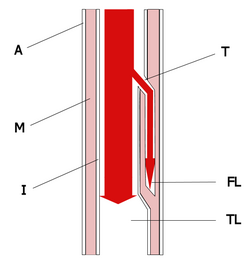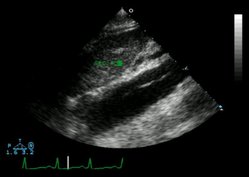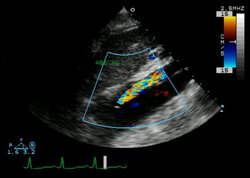Cardiovocal syndrome was first described a century ago by Ortner. He attributed a case of left vocal fold immobility to compression of the recurrent laryngeal nerve by a dilated left atrium in a patient with mitral valve stenosis. Since then, the term Ortner's syndrome has come to encompass any nonmalignant, cardiac, intrathoracic process that results in embarrassment of either recurrent laryngeal nerve--usually by stretching, pulling, or compression--and causes a vocal fold paralysis. Not surprisingly, the left recurrent laryngeal nerve, with its longer course around the aortic arch, is more frequently involved than is the right nerve, which passes around the subclavian artery. Causes of Ortner's syndrome that have been described in the literature include atrial septal defect, Eisenmenger's complex, patent ductus arteriosus, primary pulmonary hypertension, and aortic aneurysm.
A 79-year-old man had his vocal fold mobility documented as normal at a major university center following the latest of his two coronary artery bypass graft surgeries in 1998. He returned 2 years later complaining of hoarseness, but no other symptoms. His dysphonia, which had resolved after each of his previous two operations, had returned. On physical examination, a left vocal fold paralysis was observed. Computed tomography (CT) of the chest revealed a dissecting aortic aneurysm (figure), which suggested a recurrent laryngeal nerve injury that was caused by the stretching of the nerve around a slowly expanding aortic arch. This was a chronic and painless disease process. The patient was referred to a cardiologist, who prescribed treatment based on the chronic nature of his condition and the patient's overall health.
Suggested Reading
Khan IA, Wattanasauwan N, Ansari AW. Painless aortic dissection presenting as hoarseness of voice: Cardiovocal syndrome: Ortner's syndrome. Am J Emerg Med 1999;17:361-3.
Kishan CV, Wongpraparut N, Adeleke K, et al. Ortner's syndrome in association with mitral valve prolapse. Clin Cardiol 2000;23:295-7.
Thirlwall AS. Ortner's syndrome: A centenary review of unilateral recurrent laryngeal nerve palsy secondary to cardiothoracic disease. J Laryngol Otol 1997;111:869-71.
COPYRIGHT 2001 Medquest Communications, Inc.
COPYRIGHT 2002 Gale Group




